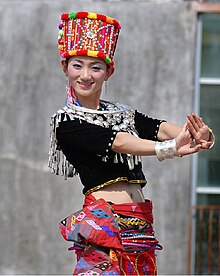Jingpo
The Jingpo or Kachin or Singpho ( Chinese 景颇族 , Pinyin Jǐngpōzú ; also: Jingpho , Jingp'o ) are an ethnic group in China , Myanmar and India .
In China, the Jingpo are one of the 55 officially recognized ethnic minorities . Most of them live in Yunnan Province . According to the last census in 2010, they counted 147,828 people. In China as well as in Myanmar, several groups, linguistically z. Sometimes they differ greatly from one another, counted as part of the Jingpo or Kachin nationality.
In Myanmar (Burma), especially in Kachin State , in the far north of the country, the Jingpo are a very large ethnic minority. They make up around 1.4% of the total population of Myanmar. In Myanmar, the term "Kachin" includes groups that speak different Tibetan Burmese languages, i.e. the Jingpaw (Jingpo in the narrower sense), the Duleng, the Maru (Lawngwaw), the Rawang, the Zaiwa and the Lachik (Lashi). Sometimes even the Lisu are added, who like Zaiwa and Maru speak a northern Lolo-Burmese language and are recognized as a separate nationality in China, Thailand and India.
In India, around 7200 Jingpo (Singpho) live in 13 villages in the districts of Lohit and Changlang in the state of Arunachal Pradesh and in the district of Tinsukia (capital: Tinsukia ) in the state of Assam . Since China regards over 90% of the territory of Arunachal Pradesh as its own national territory, it sees the Jingpo (almost 7,000) living there as part of its own ethnic minority, the Jingpo.
languages
Five languages are spoken among the Jingpo of China, four of which are also spoken by the Kachin in Myanmar.
Jingpo
Around 900,000 people in Myanmar and around 40,000 in China speak Jingpo (景颇 语, also written Jinghpaw in English , often called Kachin in Myanmar ). The Jingpo language belongs to the Bodo-Konyak-Jingpho subgroup of Tibetan Burmese. It serves as a lingua franca among the various groups of the Jingpo / Kachin, both in China and in Myanmar. A standardized version taught in China is based on the dialect of Enkun.
Zaiwa
Zaiwa (also written Tsaiva or Tsaiwa ; in Jingpo the language is Atsi , in Chinese Zǎiwǎyǔ载 瓦 语 and in Burmese Zi ) is spoken by about 80,000 people in China and about 30,000 in Myanmar. Zaiwa belongs to the Lolo-Burmese subgroup of the Tibeto-Burmese . After the founding of the People's Republic of China, a written language was created based on the dialect of Longzhun (in Xishan Township, Luxi County), which is written using the Latin alphabet. This written language was officially introduced in 1957.
Maru
Maru ( 浪 莪 語Làng'éyǔ in Chinese , also called 嬤 魯 語Mólǔyǔ ) is spoken by around 100,000 people in Myanmar and around 3,500 in China. In some Chinese sources, however, up to 20,000 speakers of the Maru in China are given. Like the Zaiwa, it belongs to the Lolo-Burmese subgroup of Tibeto-Burmese.
Lashi
Lashi (in Chinese勒 期 語Lèqíyǔ ) is spoken by around 30,000 people in Myanmar and nearly 2,000 in China. Like the Zaiwa, it belongs to the Lolo-Burmese subgroup of Tibeto-Burmese.
Bela
2,000 to 3,000 Jingpo near the city of Luxi in the Dehong Autonomous District of the Dai and Jingpo represent a special case. A good 400 of them speak Bela (also Pela , in Chinese波拉 語Bōlāyǔ , also 布拉 語Bùlāyǔ ), a language that was only described in 2004 and is apparently very close to the Zaiwa. No Bela speakers are known from Myanmar.
literature
- Liú Lù 刘 璐: Jǐngpōzú yǔyán jiǎnzhì - Jǐngpōyǔ景颇族 语言 简 志 —— 景颇 语 ( Introduction to the languages of the Jingpo nationality - Jingpo ; Běijīng 北京, Mínzú chūbǎnshè 民族 出版社 1984).
- Xú Xījiān 徐 悉 艰 u. Xú Guìzhēn 徐桂珍: Jǐngpōzú yǔyán jiǎnzhì - Zǎiwǎyǔ景颇族 语言 简 志 —— 载 瓦 语 ( Introduction to the languages of the Jingpo nationality - Tsaiva ; Běijīng 北京, Mínzú chūbǎnshè 民族 出版社 1984).
See also
Web links
- The Jingpo ethnic minority (Chinese government side)

